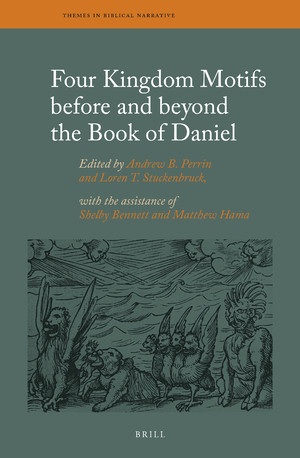
A new book edited by Andrew Perrin and Loren T. Stuckenbruck, Four Kingdom Motifs before and beyond the Book of Daniel (Brill, 2020), covers one of the most influential topics in the history of apocalyptic and millenarian movements in contexts where a version of the Bible is a main source. The e-book version is also freely available on open access.
The four kingdoms motif enabled writers of various cultures, times, and places, to periodize history as the staged succession of empires barrelling towards an utopian age. The motif provided order to lived experiences under empire (the present), in view of ancestral traditions and cultural heritage (the past), and inspired outlooks assuring hope, deliverance, and restoration (the future). Four Kingdom Motifs before and beyond the Book of Daniel includes thirteen essays that explore the reach and redeployment of the motif in classical and ancient Near Eastern writings, Jewish and Christian scriptures, texts among the Dead Sea Scrolls, Apocrypha and pseudepigrapha, depictions in European architecture and cartography, as well as patristic, rabbinic, Islamic, and African writings from antiquity through the Mediaeval eras.
The Table of Contents includes:
Andrew B. Perrin, ‘Introduction to the Four Kingdoms as a Time Bound, Timeless, and Timely Historiographical Mechanism and Literary Motif’
Michael Segal, ‘The Four Kingdoms and Other Chronological Conceptions in the Book of Daniel’
Ian Young, ‘Five Kingdoms, and Talking Beasts: Some Old Greek Variants in Relation to Daniel’s Four Kingdoms’
Alexandria Frisch, ‘The Four (Animal) Kingdoms: Understanding Empires as Beastly Bodies’
Loren T. Stuckenbruck, ‘The Apocalypse of Weeks: Periodization and Tradition-Historical Context’
Andrew B. Perrin, ‘Expressions of Empire and Four Kingdoms Patterns in the Aramaic Dead Sea Scrolls’
Olivia Stewart Lester, ‘The Four Kingdoms Motif and Sibylline Temporality in Sibylline Oracles 4’
Kylie Crabbe, ‘The Generation of Iron and the Final Stumbling Block: The Present Time in Hesiod’s Works and Days 106–201 and Barnabas 4’
Katharina Bracht, ‘The Four Kingdoms of Daniel in Hippolytus’s Commentary on Daniel’
Geoffrey Herman, ‘Persia, Rome and the Four Kingdoms Motif in the Babylonian Talmud’
Lorenzo DiTommaso, ‘The Four Kingdoms of Daniel in the Early Mediaeval Apocalyptic Tradition’
Miriam L. Hjälm, ‘The Four Kingdom Schema and the Seventy Weeks in the Arabic Reception of Daniel’
James R. Hamrick, ‘Conflicting Traditions: The Interpretation of Daniel’s Four Kingdoms in the Ethiopic Commentary (Tergwāmē) Tradition’
Brennan Breed, ‘The Politics of Time: Epistemic Shifts and the Reception History of the Four Kingdoms Schema’


